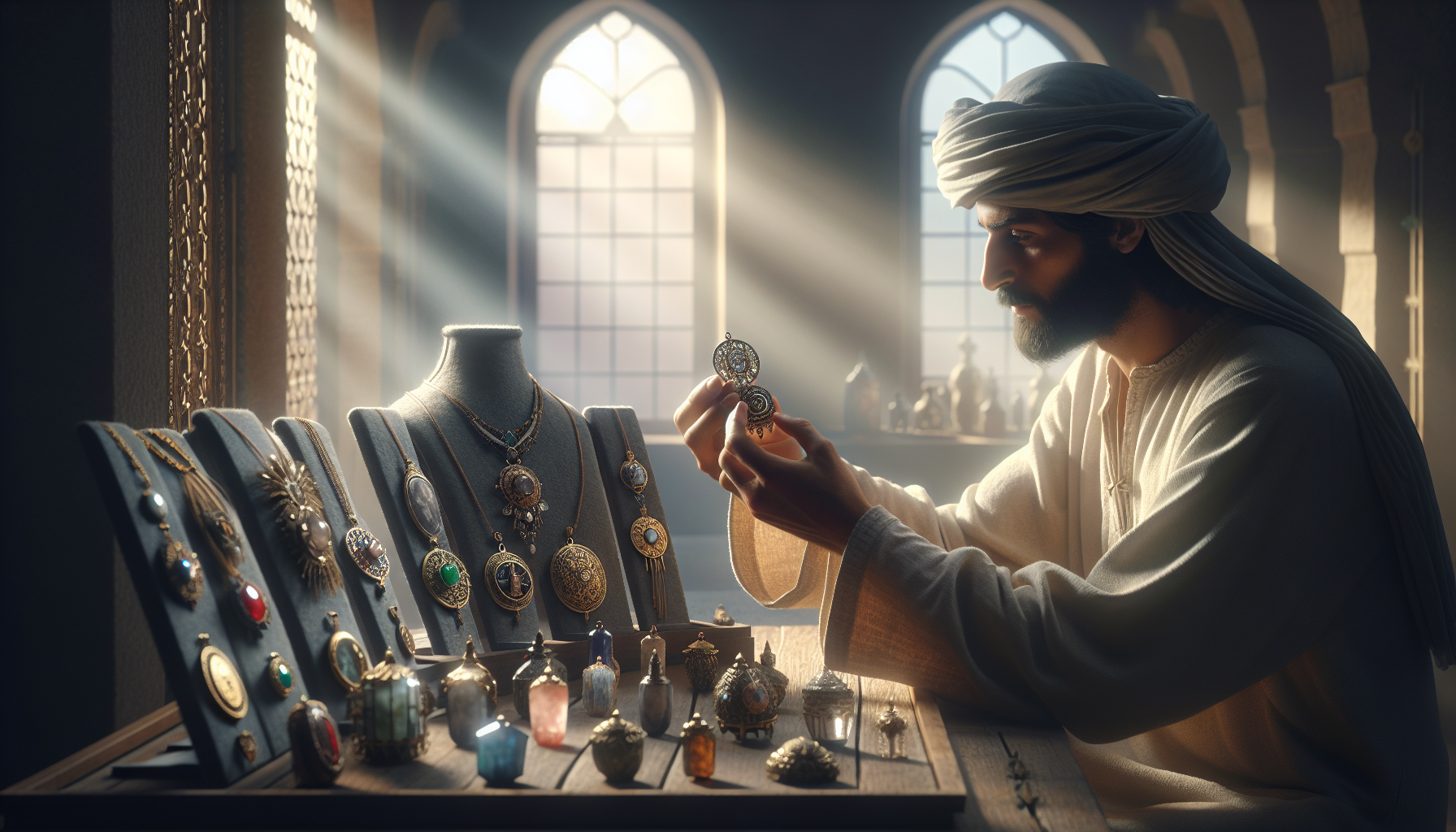In a world brimming with medical advancements and technological marvels, the quest for health and healing often seems like a path well-trodden, mapped out by scientific rigor and empirical evidence. Yet, amidst the sterile corridors of hospitals and the precise calculations of pharmaceutical interventions, there lies a rich tapestry of ancient wisdom and mystical practices that beckon us to explore healing in a more holistic and perhaps, spiritual light. Enter the world of amulets—a world where history, spirituality, and healing intertwine, offering an alternative perspective on well-being that has captivated cultures across centuries. 🌿✨
For many, amulets may conjure images of quaint trinkets or relics of folklore, seemingly incongruous with modern medicine. However, these small objects, imbued with symbolic meanings and intentions, have been revered by countless civilizations as powerful conduits of healing energy. The allure of amulets lies not merely in their aesthetic appeal but in their potential to harmonize the mind, body, and spirit—a concept gaining traction in contemporary wellness circles. As we delve into the fascinating narrative of amulets, we’ll explore their origins, the cultural significance they bear, and the scientific curiosity they continue to spark in an era dominated by evidence-based practices.
In this exploration, we will uncover the diverse types of amulets cherished worldwide and their purported healing properties. From the protective Hamsa of the Middle East to the energy-balancing crystals of New Age spirituality, each amulet carries its own story and promise of wellness. We’ll examine how these talismans have been integrated into various healing modalities, and hear from individuals who attest to their transformative effects. As we embark on this journey through history, culture, and personal testimony, prepare to challenge your perceptions and perhaps even unlock new pathways to health that honor both the mystical and the medical. Let us discover together the untapped potential that amulets hold in curing not only the ailments of the body but also the afflictions of the soul. 🌟
The Historical Significance of Amulets
Throughout history, amulets have played a vital role in various cultures around the world. These small objects, often worn as jewelry or carried on the person, have been believed to offer protection, bring good luck, and promote healing. The significance of amulets dates back to ancient civilizations such as Egypt, Mesopotamia, and China. In these societies, amulets were not only seen as decorative items but as essential tools for spiritual and physical well-being.
In Ancient Egypt, for instance, amulets were an integral part of their religious and burial practices. They were often placed within the wrappings of mummies to ensure safe passage to the afterlife. Each amulet had specific powers, such as the Eye of Horus, which was believed to protect against evil spirits and bring health to the wearer. Similarly, in Mesopotamia, amulets were commonly used in rituals to ward off demons and disease. The famous Babylonian demon Pazuzu was often depicted on amulets to protect against plagues and evil forces.
As we move further east, in Ancient China, amulets were made of jade, a stone highly prized for its supposed healing properties. Jade amulets were believed to bring longevity and prevent illness, and their use can be traced back to the Neolithic period. The belief in the power of amulets was not just limited to these ancient civilizations. Many other cultures, including the Greeks and Romans, also utilized amulets, reflecting a universal belief in their protective and healing abilities.
Amulets in Modern Times
In today’s world, amulets continue to hold a place of importance, although their use and perception may have evolved. In many cultures, amulets are still regarded as symbols of faith and protection. The continuous interest in amulets can be seen in the resurgence of traditional medicine and holistic healing practices, where individuals seek alternative methods for health and well-being.
Amulets today are often crafted from various materials, including metals, stones, and organic substances, each chosen for its symbolic or supposed healing properties. For instance, in modern crystal healing practices, amulets made from quartz or amethyst are popular for their purported ability to balance energy and enhance mental clarity. This reflects a broader trend of incorporating ancient wisdom and spiritual practices into contemporary wellness routines.
Moreover, with the advent of technology, the influence of amulets has extended into the digital realm. Digital amulets, in the form of smartphone apps or wearable technology, offer a modern twist on this ancient practice. These digital solutions are designed to provide reminders for mindfulness, stress reduction, and even health monitoring, embodying the age-old desire for protection and healing in a new format.
Types of Amulets and Their Uses
Amulets come in various forms and serve different purposes, depending on cultural beliefs and individual needs. Understanding the types of amulets and their uses can provide insight into how they may be applied for healing and protection. Below is a table that highlights some common types of amulets and their intended effects:
| Type of Amulet | Purpose |
|---|---|
| Eye of Horus | Protection against evil and health improvement |
| Jade Amulet | Longevity and prevention of illness |
| Hamsa Hand | Protection from the evil eye and bringing good fortune |
| Crystals (Quartz, Amethyst) | Energy balancing and mental clarity |
| Pazuzu Amulet | Protection against plagues and evil spirits |
For a deeper understanding of how amulets are used in modern holistic practices, watch this insightful video from the “Holistic Healing Hub” channel. 🎥✨
Choosing the Right Amulet
When selecting an amulet, it is important to consider its intended purpose and how it resonates with you personally. The process of choosing an amulet can be an intuitive experience, where one feels drawn to a specific symbol or material. It is also helpful to research the cultural and historical background of the amulet to understand its traditional uses and meanings.
- Consider what aspect of life you wish to influence, such as health, protection, or prosperity.
- Research the materials and symbols that are traditionally associated with these desires.
- Trust your instincts and choose an amulet that you feel a personal connection with.
Amulets and Science: Bridging the Gap
The use of amulets raises interesting questions about the intersection of belief, spirituality, and science. While there is limited scientific evidence to support the healing properties of amulets, their continued popularity suggests that they fulfill important psychological and emotional needs for many people.
From a scientific perspective, the power of amulets may be attributed to the placebo effect, where the belief in the efficacy of an object or treatment can lead to real improvements in health and well-being. This psychological phenomenon highlights the significance of belief and intention in the healing process, suggesting that amulets may work by enhancing an individual’s mindset and reducing stress.
Moreover, some researchers have explored the concept of “biofields,” which refers to the idea that living organisms emit energy fields that can influence health. While this area of study is still in its infancy, it offers a potential explanation for how amulets might exert an effect on the body and mind.
The Role of Amulets in Complementary Medicine
In the realm of complementary and alternative medicine (CAM), amulets are often used alongside other holistic practices to support overall wellness. CAM practitioners may integrate amulets into treatment plans that include herbal remedies, acupuncture, and meditation, creating a comprehensive approach to health.
- Amulets can be worn during meditation to enhance focus and intention.
- They may be placed in healing spaces to promote a positive energy environment.
- Practitioners might use amulets in combination with aromatherapy or sound healing sessions.
By incorporating amulets into these practices, individuals may experience a greater sense of empowerment and connection to their healing journey, regardless of the scientific evidence supporting their use.

Conclusion
Unlocking the power of healing through amulets is an intriguing concept that seamlessly blends tradition, spirituality, and modern-day holistic health practices. Throughout this article, we explored the historical significance and cultural importance of amulets, delved into the diverse types of amulets used across different cultures, and examined the potential psychological and physiological benefits they may offer. By integrating historical insights with contemporary understandings, we illuminated how these small objects can be perceived as potent symbols of protection and healing.
Amulets have been revered across civilizations for their perceived ability to ward off negative energies and promote health and well-being. From the ancient Egyptians, who often included amulets in the wrappings of mummies, to modern practitioners who use them as part of holistic health regimens, these artifacts carry a rich legacy. Each culture has its unique interpretations and designs, ranging from the Ankh and Eye of Horus to the Nazar and various gemstones known for their healing properties.
One of the crucial points we examined is the psychological impact of amulets. The belief in their power can serve as a form of placebo effect, where the wearer’s positive expectations contribute to actual health improvements. This demonstrates the profound connection between mind and body, suggesting that what we believe can significantly influence our physical health. Furthermore, amulets can serve as tangible reminders of personal intentions and affirmations, reinforcing mental resilience and emotional stability.
On a physiological level, some researchers suggest that certain materials used in amulets, such as copper and specific gemstones, may have inherent health benefits. For instance, copper is thought to have anti-inflammatory properties, and various crystals are believed to emit frequencies that can align with the body’s energy fields. While scientific validation is still ongoing, these traditional beliefs open avenues for further exploration into how materials may impact health.
The cultural and spiritual dimensions of amulets also play a vital role in their healing potential. Many people find comfort and strength in their spiritual beliefs, and amulets often serve as physical manifestations of these beliefs. Whether it’s through prayer, meditation, or ritualistic use, the spiritual connection fostered by amulets can promote a sense of peace and holistic healing.
In reinforcing the importance of this topic, it’s essential to recognize the blend of ancient wisdom and modern science that amulets embody. They remind us that healing is not solely about addressing physical symptoms but involves a comprehensive approach that includes mental and emotional well-being. In an age where stress and anxiety are prevalent, finding ways to connect with our heritage and spirituality can offer solace and empowerment.
We encourage you to reflect on the information shared in this article and consider how the principles discussed might apply to your own life. Whether you choose to explore amulets as part of a broader health strategy or as a cultural curiosity, the journey of discovery can be both enlightening and transformative. Share your thoughts and experiences with others who may benefit from this knowledge. Discussing and sharing can create a community of support and learning, fostering a deeper understanding of how ancient practices can find relevance in our modern world.
If you are interested in further exploring this fascinating subject, we recommend visiting reputable sources that provide a wealth of knowledge on the cultural significance and modern applications of amulets. Engaging with such resources can deepen your understanding and perhaps inspire new ways to incorporate these practices into your life:
1. The Smithsonian Institution provides extensive research on the cultural artifacts, including amulets, from various civilizations: Smithsonian Institution
2. For a scientific perspective on the placebo effect and mind-body connection, consider exploring the work available at the Mayo Clinic: Mayo Clinic
3. Crystal and mineral enthusiasts may find additional insights on the potential healing properties of gemstones at the International Gem Society: International Gem Society
As we conclude this exploration, may you find inspiration in the rich tapestry of history, culture, and healing that amulets represent. Embrace the potential for growth and healing they symbolize, and may your journey be filled with discovery and well-being. Thank you for being part of this discussion, and we look forward to your thoughts and insights. Let’s continue to unlock the power of healing together! 🌟
Toni Santos is a visual storyteller and conceptual archivist whose work explores the curious, often poetic ruins of pseudoscience and obsolete theories. With a reverence for forgotten frameworks and fantastical logic, Toni illuminates the imaginative spaces where science once drifted into myth, speculation, and symbolic belief.
His creative path is rooted in a fascination with the fringe — from phrenology maps to ether diagrams, hollow earth charts to animal magnetism illustrations. Each visual Toni creates or curates is an invitation to reexamine the strange beauty of discarded knowledge — not as failure, but as cultural reflection, as art born from our eternal desire to explain the unexplainable.
Blending visual design with historical inquiry, Toni gives new life to lost diagrams, metaphysical charts, and antique engravings that once shaped worldviews. His work occupies the liminal zone between fact and fiction, where obsolete models still pulse with philosophical resonance and forgotten charm.
As the mind behind Vizovex, Toni shares illustrated essays, curated collections, and visual reinterpretations that invite others to explore the aesthetic and symbolic value of outdated theories. His goal is not to validate, but to remember — to view these speculative systems as relics of human creativity, vulnerability, and yearning.
His work is a tribute to:
The elegance of error in the evolution of knowledge
The symbolic artistry of discarded explanations
The blurred lines between belief, observation, and imagination
Whether you’re a collector of curious ideas, a lover of forgotten diagrams, or someone drawn to the strange scaffolding of old worldviews, Toni opens a portal to a time when the universe was still full of ghosts, humors, and cosmic fluids — one chart, one symbol, one discredited wonder at a time.





